In Gaza’s southernmost city, the Israeli army says the terror group’s operatives have embedded themselves inside booby-trapped buildings and tunnels.
Article content
RAFAH, Gaza Strip — Shots rang out in the Yabna camp in the Gaza Strip’s southernmost city, as troops of the Givati Infantry Brigade closed in on an RPG-wielding Hamas operative who had been spotted just a few hundred meters from Col. Liron Betito’s makeshift command center.
Betito, who commands Givati, was giving Israeli reporters a tour of Yabna — known in the Israel Defense Forces as NPK — on Tuesday, highlighting the brigade’s successes and challenges in this now deserted neighborhood of Rafah.
Advertisement 2
Article content
“They identified a terrorist, approaching the force with an RPG, a sniper team identified him, hit him, but I’m not sure if we killed him, they are verifying it now,” the colonel said after speaking to a subordinate over the radio, just as the journalists left a heavily damaged apartment building where Givati had set up shop.
The infantry brigade entered Rafah along with other troops from the 162nd Division in early May. As armored forces captured the Rafah Crossing with Egypt and the so-called Philadelphi Route — the Egypt-Gaza border area — Betito’s brigade pushed for Gaza’s key north-south road, Salah a-Din.
Recommended from Editorial
In the following weeks, Givati pushed deeper into Rafah, operating in Yabna and other neighborhoods where Hamas had built up its infrastructure. Most recently, the brigade has been readying itself for an offensive in Shaboura, a neighborhood in central Rafah adjacent to Yabna.
The Hamas fighter with an RPG was a relatively rare sight for the troops fighting in Rafah. Unlike in other areas of Gaza, the terror group largely abandoned its posts, with very few operatives attempting to engage Israeli forces in close quarters.
Article content
Advertisement 3
Article content
Instead, Betito said, Hamas operatives have booby-trapped a vast number of homes in Rafah, and wait in tunnels for his troops to arrive. Hamas has used difficult-to-spot car backup cameras to identify when troops arrive at a booby-trapped building and detonate the explosives.
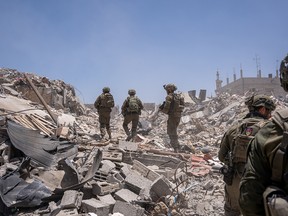
In one such an incident last week, five soldiers of the brigade’s reconnaissance unit were killed after a booby-trapped home exploded and part of the building collapsed on the troops.
“Hamas took an approach here where it avoided fighting with terrorists at the front, but instead chose to booby-trap [buildings]. And it booby-trapped loads of buildings. I haven’t seen this many booby-trapped buildings before,” Betito, whose brigade has been operating in Gaza since the beginning of the war, told The Times of Israel.
“Our challenge is trying to locate them ahead of time,” he said.
According to military assessments, Hamas’s Rafah Brigade was bolstered by terror operatives who fled from northern Gaza and other parts of the Strip as the IDF first operated there. This gave the Rafah Brigade, considered by the IDF as the weakest of Hamas’s brigades, considerable time and manpower to prepare itself for the looming Israeli offensive in southern Gaza.
Advertisement 4
Article content
Still, as the IDF began its operation in Rafah, the military assessed that only 2,000 terror operatives remained in the city, meaning that many had fled with the estimated 1.2 million civilians to an Israeli-designated “humanitarian zone” further north.
As of Tuesday, the IDF said it has killed at least 550 armed operatives in Rafah amid the fighting, with many more believed dead in airstrikes on buildings and tunnels.
Tunnels are Hamas’s ‘center of gravity’
While only 550 gunmen have been killed in Rafah, the military said it had dismantled about half of Hamas’s fighting force in Rafah. Of the four battalions in Hamas’s Rafah Brigade, two — Yabna (South) and East Rafah — are considered to be almost completely dismantled, while the capabilities of the other two — Shaboura (North) and Tel Sultan (West) — are somewhat degraded due to IDF operations.
Betito said the most reliable indicator for determining if a Hamas battalion is dismantled is if its military infrastructure — especially its tunnels — is destroyed. He said that of the 150 or so Hamas operatives his troops located and killed in Rafah, nearly all were hiding in tunnels.
Advertisement 5
Article content
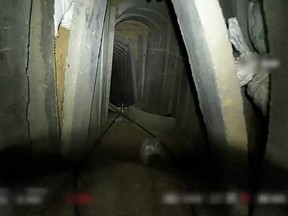
“The center of gravity is the tunnels. If we don’t [dismantle] the tunnels, it is very hard to control the area. You can be above ground operating freely, but [Hamas] can surprise you from underground,” he said, noting that the entrances to such tunnels are mostly hidden inside the booby-trapped buildings, forcing Israeli forces to inspect them.
“In the end, if I want to hold the area properly, I need to reach underground, locate tunnel shafts, put explosives inside, destroy it, locate the next shaft, and demolish the whole network. This way, [Hamas] will have no choice but to either die inside [the tunnel] or to come outside. Above ground, I want them there, I have a major advantage there,” Betito said.
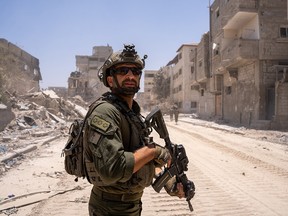
As many as 25 major tunnels have been found so far by the IDF along the Philadephi Route, reaching up to the border with Egypt, some of which likely crossed into Sinai and were used by Hamas to smuggle weapons. Combat engineers have been digging down along the border, in an attempt to sweep the entire 14-kilometer axis of Hamas’s underground smuggling routes.
Meanwhile, Betito said his troops had also encountered freshly dug tunnels while operating in Rafah, in addition to the major underground networks built up by Hamas over the past decade and a half
Advertisement 6
Article content
“Not everything was the way we thought it would be. We found places where new routes were [dug],” he said.
In a recent incident, Hamas operatives burrowed a tunnel under an IDF encampment in Rafah and using a newly dug shaft, attempted to place an explosive device next to an armored vehicle, highlighting the terror group’s ability to quickly build new infrastructure.
East Rafah flattened
The journey to Rafah’s Yabna from the Kerem Shalom area in southern Israel only took about 15 minutes in an open-top humvee.
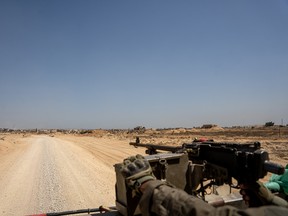
The first section of the drive, from the Gaza border to the Rafah Crossing, was along a new road built by the army, dubbed David’s Route. From there, the humvees drove along the Philadelphi corridor to the central part of the city.
On the eastern outskirts of Rafah, close to the Israeli border, nearly every single building visible along David’s Route was flattened, as part of the IDF’s plans to construct a kilometer-long buffer zone.
The Rafah Crossing was also in no shape to be used again to deliver much-needed aid to the Strip. Many of the buildings are damaged, including the crossing’s main terminal building which was also burnt in recent days.
Advertisement 7
Article content

No Palestinian civilians were seen in the Rafah area, although a few dozen empty trucks were lined up near Kerem Shalom to transport aid from the border crossing with Israel to the humanitarian zone.
‘Demolish them entirely’
As the IDF works to demolish Hamas’s tunnel networks in Rafah, Betito said he expects the operation against the terror group in the southern Gaza city to wrap up within a month.
“I estimate that to [achieve] our next objective, which is to finish up Shaboura and Tel Sultan… we want to demolish them entirely, it will take more or less a month, at this level of intensity,” he said.
The operation in Rafah is being carried out in a “precise manner,” the IDF has said. This is due to sensitivities surrounding the border with Egypt, amid strained ties between the nations, as well as due to the possibility that hostages abducted by the terror group may still be held by Hamas in the city.
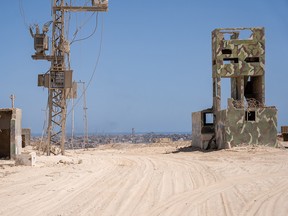
But Betito said the extra time being taken to tackle Hamas in Rafah, as well as weeks of delays before the operation began, has made little to no difference.
“Naturally, the place you reach last [in Gaza], is more prepared. It doesn’t matter an extra week or two or a month. [Hamas] doesn’t have tanks, armored personnel carriers, or an air force. It’s the same terrorists with the same anti-tank projectiles, the same tunnels,” he said.
“We need to act smart, act with reason, protect our forces, but bring forth our power. It’s only a matter of time,” Betito added.
This article was originally published on The Times of Israel
Article content







